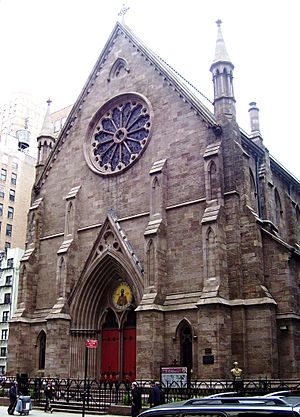Serbian Americans facts for kids

|
|
| Total population | |
|---|---|
| 189,671(ACS estimate)-1,000,000+(est.) | |
| Regions with significant populations | |
| Languages | |
| American English and Serbian | |
| Religion | |
| Serbian Orthodox Church | |
| Related ethnic groups | |
| Serbian Canadians and other Slavic Americans |
Serbian Americans (Serbian: Српски Американци / Srpski Amerikanci), also known as American Serbs (Serbian: Амерички Срби / Američki Srbi), are United States citizens whose ancestors are Serbs. As of 2013, there were about 190,000 American citizens who said that they had Serb ancestry. However, the number may be much higher, as there were also 290,000 people who said that they were Yugoslavs living in the United States. The group includes Serbian Americans living in the United States for one or many generations, people who are citizens of both Serbia and the United States, or any other people who say that they are both Serbian and American.
History
One of the first Serb immigrants to the United States was the settler George Fisher, who came to Philadelphia in 1815, moved to Mexico, fought in the Texan Revolution, and became a judge in California. Another important early Serb in America was Basil Rosevic, who started a shipping company, the Trans-Oceanic Ship Lines, around the year 1800. In the early 1800s, many Serb sailors and fishermen from Montenegro and Herzegovina came to New Orleans looking for work. In 1841, Serbs founded the Greek Orthodox parish with Greek immigrants in New Orleans.
Serbian Americans fought in the American Civil War, mostly on the side of the Confederacy, as most Serbs living in America were in Louisiana and Mississippi. A few Confederate military units were started by Serbs in Louisiana, such as the Cognevich Company (named for Stjepan Konjevic, who immigrated to Louisiana in the 1830s), and the First and Second Slavonian Rifles. At least 400 Serbs fought in these three units during the Civil War. Several other known Serbs who fought in the Civil War came from Alabama and Florida, specifically from Pensacola.
Some Serbian Americans went back to Serbia to fight in the First Balkan War. During World War I, as many as 15,000 Serbian Americans went back to the Balkans to fight. Serbs in the United States who did not fight in the war raised knowledge, campaigned for the creation of Yugoslavia, sent aid to the Balkans through the Red Cross, formed a Serbian Relief Committee, and urged important Americans to support the Serbian cause.
After World War II many Serbs immigrated to the United States from Yugoslavia after Josip Broz Tito took control of the country. Since then, many Serbian American organizations have been formed in the United States. A number of Serbian American engineers worked on the Apollo program.
Alaska
Serbs have lived in Alaska since the first Serbs came to America in the 19th century. Many Serbs came in the Klondike Gold Rush in the late 1890s to earn money, just like they had done in the California Gold Rush.
The places where most Serbs settled in Alaska were Juneau, Douglas, Fairbanks, and Sitka. Many Serbs also settled in the Canadian Yukon during the gold rush as well, such as the legendary gold miner Black Mike Vojnić.
In 1893, Serbian miners in Alaska built the Orthodox Church in Juneau with the native Orthodox Tlingit people, who had been converted to Orthodoxy by the Russians decades before. During the First World War, many Serbian Americans went back to Serbia to fight, and thousands of them came from Alaska.
In recent years, it has become common for Serbian workers to come to Alaska every year to work for a few months in canneries, where food and living space is given to them. These workers stay in Alaska on temporary work visas, and speak English.
Population
Demographics
| Year | Number |
|---|---|
| 1980 |
100,941
|
| 1990 |
116,975
|
| 2000 |
140,337
|
| 2010 |
187,739
|
In the past, number of Serbs who immigrated to the United States was difficult to find as Serb immigrants were often recorded by their country of origin, so as Turks, Croats, Slovenes, Montenegrins, Dalmatians, Bosnians, Herzegovinians and Austro-Hungarians. In the 1910 census, there were 16,676 Serbs from Austria-Hungary, 4,321 from Serbia, and 3,724 from Montenegro.
187,738 citizens of the United States said that they Serb ethnicity in 2010. The 2012 American Community Survey estimated that there were 199,080 Americans with Serb ancestry. It is likely that some of the American citizens who said that they had Yugoslavian ethnicity (328,547 in 2010; 310,682 in 2012 estimation) are also ethnic Serbs.
Places in the United States where many Serbs have settled include Chicago, New York City, Indianapolis, Milwaukee, Pittsburgh, Phoenix, and Jackson, California.
Serbian-born population
Serbian-born population in the US since 2010:
| Year | Number |
|---|---|
| 2010 | 30,715 |
| 2011 | |
| 2012 | |
| 2013 | |
| 2014 | |
| 2015 | |
| 2016 | |
| 2017 |
Images for kids
-
First meeting of the NACA in 1915 (Mihajlo Pupin seated first from right)
-
The St. Nicholas Orthodox Church in Juneau, which was built by Serbs and Tlingit natives.
-
Nikola Tesla Corner in New York City





